|
Android Intent?是承载一个意图,即对象。将消息从一个组件传到另一个组件,在应用程序或应用程序之外。Intent?之间沟通信息的任何应用程序的三个核心组件 - 活动,服务和广播接收器。
意图本身是一个Intent对象,是一种被动的数据结构保持将要执行的动作的抽象描述。 |
例如,让我们假设有一个Activity ,需要启动电子邮件客户端和发送电子邮件,使用Android设备。为了达到这个目的,Activity会随着适当选择器,一个ACTION_SEND发送到 Android Intent 解析器。指定的选择器提供适当的接口供用户选择如何发送电子邮件数据。
例如,有一个Activity ,需要在 Android 设备上用Web浏览器打开网址。为了达到这个目的Activity将发送ACTION_WEB_SEARCH?Intent?到Android?Intent?解析器,并在Web浏览器中打开给定的URL。Intent?解析器解析通过一个活动列表,并选择一个最合适的?Intent?,在这种情况下,就是Web浏览器活动。Intent通过网页解析后,网页浏览器启动 Web 浏览器活动。
分开机制对于每种类型的组件提供意图,如:活动,服务和广播接收器。
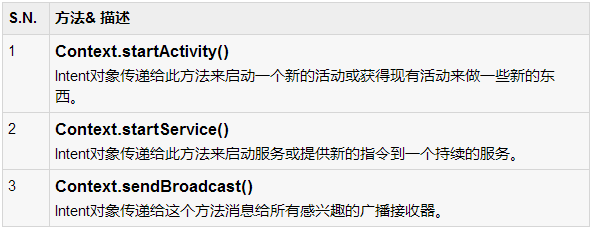
Intent对象
Intent对象是成捆的信息,这些信息所使用的组件,它接收的意图和Android系统中的信息。
Intent对象可以基于它是什么交流或要执行,包含以下组件:
动作
强制Intent对象是一个字符串,命名要执行操作或广播意图,正在发生的动作和报告。动作在很大程度上决定意图对象的其余部分的结构如何。Intent类定义了一些动作常数对应不同的意图。下面列出的是Android Intent标准动作
动作在一个Intent对象的 setAction() 方法可以设置,通过 getAction() 方法读取。
数据
要采取动作的数据的URI和该数据的MIME类型。例如,如果动作字段ACTION_EDIT,在数据字段将包含要显示的编辑的文档的URI。
setData()方法指定数据仅作为URI的setType()指定它只能作为一个MIME类型,和setDataAndType()指定它作为一个URI和MIME类型。读取的URI由getData()和getType()。
操作/数据对的一些例子是:
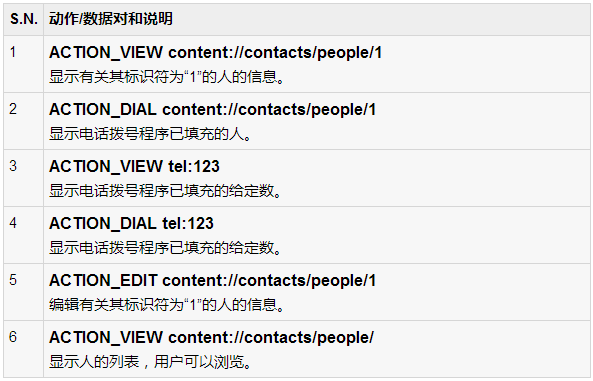
类别
类别是 Intent 对象一个可选部分,这是一个字符串,其中包含应该处理这个 Intent 组件的附加信息。 addCategory()方法将类别添加到 Intent对象,removeCategory() 删除一个类别,GetCategories() 得到当前在对象的所有类别集合。下面是 Android意图标准类别 列表。
要查看详细的 Intent过滤器可在下一小节,了解如何使用类别,选择合适的活动对应的意图。
附加设备
这是键-值对,可了解更多传递组件处理 intent 的信息。额外内容设置和读取使用 putExtras() 和 getExtras() 方法。这里是一个 Android intent?标准额外数据列表。
标志位
这些标志是Intent对象可选部分,并指示Android系统如何启动一个活动以及如何对待它在启动后等等。
组件名称
可选字段是一个 android 组件名称的活动,服务或BroadcastReceiver类对象。如果它没有被设置,Android使用Intent 对象的信息,找到一个合适的目标,Intent 对象传递到指定类的一个实例。
组件名称由setComponent(),setClass()设置,由 setClassName()和 getComponent()读取。
Intents类型
有以下两种类型的意图支持到 Android 4.1版本
显式意图
显示意图指定目标组件的名称,通常用于应用程序内部消息 - 比如一个活动启动从??服务或启动一个组活动。例如:
// Explicit Intent by specifying its class name
Intent i = new Intent(this, TargetActivity.class);
i.putExtra("Key1", "ABC");
i.putExtra("Key2", "123");
// Starts TargetActivity
startActivity(i); |
隐式意图
这些意图由其的名字指定目标组件,它们通常用于应用程序内部消息 - 例如一个活动启动一个附属服务或启动一个姐妹的活动。例如:
// Implicit Intent by specifying a URI
Intent i = new Intent(Intent.ACTION_VIEW,
Uri.parse("http://www.example.com"));
// Starts Implicit Activity startActivity(i); |
目标组件接收的意图可以使用getExtras()方法来获得组件发送额外的数据源。例如:
// Get bundle object at appropriate place in your code Bundle extras = getIntent().getExtras();
// Extract data using passed keys
String value1 = extras.getString("Key1");
String value2 = extras.getString("Key2"); |
例子
下面的例子展示了Android意图的功能,启动各种 Android 的内置应用。
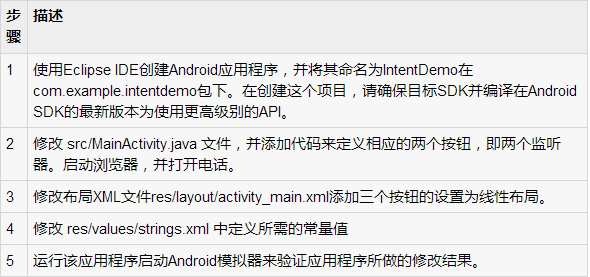
下面的例子展示了Android意图的功能,启动各种 Android 的内置应用。
package com.example.intentdemo;
import android.net.Uri;
import android.os.Bundle;
import android.app.Activity;
import android.content.Intent;
import android.view.Menu;
import android.view.View;
import android.widget.Button;
public class MainActivity extends Activity {
@Override
protected void onCreate(Bundle savedInstanceState) {
super.onCreate(savedInstanceState);
setContentView(R.layout.activity_main);
Button startBrowser = (Button) findViewById(R.id.start_browser);
startBrowser.setOnClickListener(new View.OnClickListener() {
public void onClick(View view) {
Intent i = new Intent(android.content.Intent.ACTION_VIEW,
Uri.parse("http://www.example.com"));
startActivity(i);
}
});
Button startPhone = (Button) findViewById(R.id.start_phone);
startPhone.setOnClickListener(new View.OnClickListener() {
public void onClick(View view) {
Intent i = new Intent(android.content.Intent.ACTION_VIEW,
Uri.parse("tel:9510300000"));
startActivity(i);
}
});
}
@Override
public boolean onCreateOptionsMenu(Menu menu) {
// Inflate the menu; this adds items to the action
// bar if it is present.
getMenuInflater().inflate(R.menu.main, menu);
return true;
}
} |
下面是 res/layout/activity_main.xml 文件的内容:
<LinearLayout xmlns:android="http://schemas.android.com/apk/res/android"
android:layout_width="fill_parent"
android:layout_height="fill_parent"
android:orientation="vertical" >
<Button android:id="@+id/start_browser"
android:layout_width="fill_parent"
android:layout_height="wrap_content"
android:text="@string/start_browser"/>
<Button android:id="@+id/start_phone"
android:layout_width="fill_parent"
android:layout_height="wrap_content"
android:text="@string/start_phone" />
</LinearLayout> |
下面 res/values/strings.xm 定义两个新的常量的内容:
<?xml version="1.0" encoding="utf-8"?>
<resources>
<string name="app_name">IntentDemo</string>
<string name="action_settings">Settings</string>
<string name="hello_world">Hello world!</string>
<string name="start_browser">Start Browser</string>
<string name="start_phone">Start Phone</string>
</resources> |
以下是 AndroidManifest.xml 文件的默认内容:
<?xml version="1.0" encoding="utf-8"?>
<manifest xmlns:android="http://schemas.android.com/apk/res/android"
package="com.example.intentdemo"
android:versionCode="1"
android:versionName="1.0" >
<uses-sdk
android:minSdkVersion="8"
android:targetSdkVersion="17" />
<application
android:allowBackup="true"
android:icon="@drawable/ic_launcher"
android:label="@string/app_name"
android:theme="@style/AppTheme" >
<activity
android:name="com.example.intentdemo.MainActivity"
android:label="@string/app_name" >
<intent-filter>
<action android:name="android.intent.action.MAIN" />
<category android:name="android.intent.category.LAUNCHER" />
</intent-filter>
</activity>
</application>
</manifest> |
现在运行 IntentDemo应用程序。假设创建AVD同时做正确的环境设置。要从Eclipse运行的应用程序,打开一个项目的活动文件,并 从工具栏上单击“Run”  图标。 Eclipse AVD安装的应用程序,并启动它,如果一切都设置和应用没有问题,它会显示以下模拟器窗口: 图标。 Eclipse AVD安装的应用程序,并启动它,如果一切都设置和应用没有问题,它会显示以下模拟器窗口:
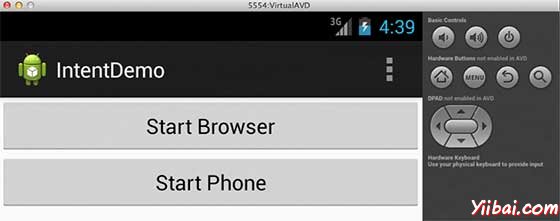
现在点击开始浏览按钮,这将启动一个浏览器配置并显示 http://www.example.com 如下所示:
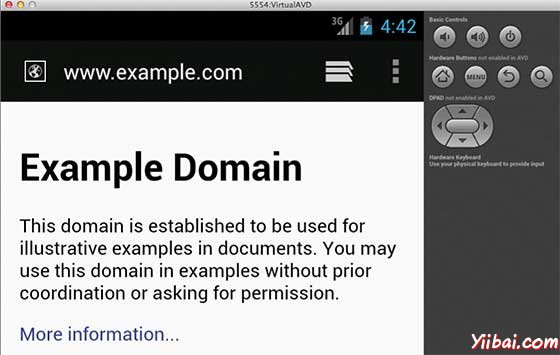
类似的方式,可以启动手机界面使用开始电话按钮,这允许拨打已经给定的电话号码。
Intent过滤器
上面已经看到了意图如何用来调用一个活动。 Android操作系统使用过滤器来查明活动,服务和广播接收器能够处理指定的一组动作,类别。使用 元素在 manifest 文件中,列出了动作,类别和数据类型相关联的活动,服务或广播接收器。
以下是 AndroidManifest.xml 文件中的一部分,指定活动 com.example.intentdemo.CustomActivity 的两个动作,类和数据,下面是可以调用的一个例子:
<activity android:name=".CustomActivity"
android:label="@string/app_name">
<intent-filter>
<action android:name="android.intent.action.VIEW" />
<action android:name="com.example.intentdemo.LAUNCH" />
<category android:name="android.intent.category.DEFAULT" />
<data android:scheme="http" />
</intent-filter>
</activity> |
活动的定义是随着上面提到的过滤器,活动将使用 android.intent.action.VIEW 或 com.example.intentdemo.LAUNCH 动作提供其类别来调用这个活动,否则使用android.intent.category.DEFAULT。
[data]元素活动被称为指定数据类型,上面的例子中自定义活动的数据以 "http://" 开始
有可能在只是一个意图的情况下,可以通过一个以上的活动或服务的过滤器,用户可能会被要求指定激活哪个组件。可以发现如果没有指定目标,则会引发异常。
以下测试 Android 检查在调用活动前:
-
如上图所示,但这个列表不能为空,可能会列出多个过滤器<intent-filter>动作,一个过滤器必须至少包含一个<action>元素,否则会阻止所有意图。如果有一个以上的动作列出,那么Android将尝试匹配在调用活动之前所提到的其中一个动作。
-
过滤器<intent-filter>可能列出零个,一个或一个以上。如果没有类被提到,Android也能通过这个测试,但如果超过一个类提到通过类的测试意图,在过滤器中,每一个类中的Intent对象必须符合一个类。
-
每个<data>元素可以指定一个URI和数据类型(MIME媒体类型)。单独的属性,如方案,主机,端口和路径URI的每个部分。同时包含URI和数据类型的一个Intent对象通过测试,只有当它的类型在过滤器列出的类型相匹配数据类型的一部分。
例子
下面是修改上面例子的一个例子。在这里将看到 Android 如何解决冲突,如果一个意图调用定义了两个活动,接下来如何调用自定义活动使用一个过滤器,第三个是一个在例外情况下,如果 Android 不提交适当的活动意图定义。
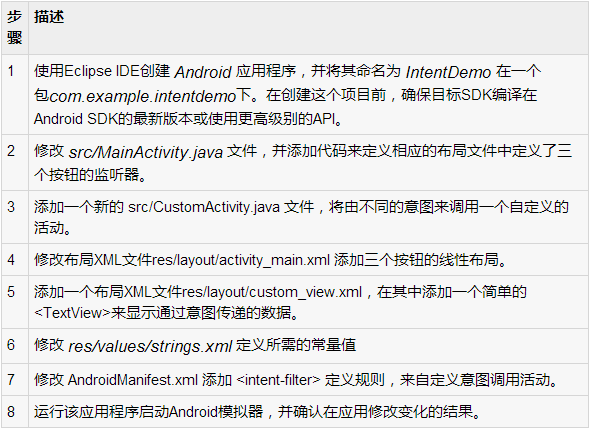
以下是内容是修改了主要活动文件 src/com.example.intentdemo/MainActivity.java.
package com.example.intentdemo;
import android.net.Uri;
import android.os.Bundle;
import android.app.Activity;
import android.content.Intent;
import android.view.Menu;
import android.view.View;
import android.widget.Button;
public class MainActivity extends Activity {
@Override
protected void onCreate(Bundle savedInstanceState) {
super.onCreate(savedInstanceState);
setContentView(R.layout.activity_main);
// First intent to use ACTION_VIEW action with correct data
Button startBrowser_a = (Button) findViewById(R.id.start_browser_a);
startBrowser_a.setOnClickListener(new View.OnClickListener() {
public void onClick(View view) {
Intent i = new Intent(android.content.Intent.ACTION_VIEW,
Uri.parse("http://www.example.com"));
startActivity(i);
}
});
// Second intent to use LAUNCH action with correct data
Button startBrowser_b = (Button) findViewById(R.id.start_browser_b);
startBrowser_b.setOnClickListener(new View.OnClickListener() {
public void onClick(View view) {
Intent i = new Intent("com.example.intentdemo.LAUNCH",
Uri.parse("http://www.example.com"));
startActivity(i);
}
});
// Third intent to use LAUNCH action with incorrect data
Button startBrowser_c = (Button) findViewById(R.id.start_browser_c);
startBrowser_c.setOnClickListener(new View.OnClickListener() {
public void onClick(View view) {
Intent i = new Intent("com.example.intentdemo.LAUNCH",
Uri.parse("https://www.example.com"));
startActivity(i);
}
});
}
@Override
public boolean onCreateOptionsMenu(Menu menu) {
// Inflate the menu; this adds items to the
// action bar if it is present.
getMenuInflater().inflate(R.menu.main, menu);
return true;
}
} |
以下是修改的主要活动文件的内容src/com.example.intentdemo/CustomActivity.java.
package com.example.intentdemo;
import android.app.Activity;
import android.net.Uri;
import android.os.Bundle;
import android.widget.TextView;
public class CustomActivity extends Activity {
@Override
public void onCreate(Bundle savedInstanceState) {
super.onCreate(savedInstanceState);
setContentView(R.layout.custom_view);
TextView label = (TextView) findViewById(R.id.show_data);
Uri url = getIntent().getData();
label.setText(url.toString());
}
} |
以下是?res/layout/activity_main.xml?文件的内容:
<LinearLayout xmlns:android="http://schemas.android.com/apk/res/android"
android:layout_width="fill_parent"
android:layout_height="fill_parent"
android:orientation="vertical" >
<Button android:id="@+id/start_browser_a"
android:layout_width="fill_parent"
android:layout_height="wrap_content"
android:text="@string/start_browser_a"/>
<Button android:id="@+id/start_browser_b"
android:layout_width="fill_parent"
android:layout_height="wrap_content"
android:text="@string/start_browser_b"/>
<Button android:id="@+id/start_browser_c"
android:layout_width="fill_parent"
android:layout_height="wrap_content"
android:text="@string/start_browser_c"/>
</LinearLayout> |
下面是?res/layout/custom_view.xml?文件的内容:
<?xml version="1.0" encoding="utf-8"?>
<LinearLayout xmlns:android="http://schemas.android.com/apk/res/android"
android:orientation="vertical"
android:layout_width="fill_parent"
android:layout_height="fill_parent" >
<TextView android:id="@+id/show_data"
android:layout_width="fill_parent"
android:layout_height="400dp"/>
</LinearLayout> |
下面 res/values/strings.xml 文件内容中定义两个新的常量:
<?xml version="1.0" encoding="utf-8"?>
<resources>
<string name="app_name">IntentDemo</string>
<string name="action_settings">Settings</string>
<string name="hello_world">Hello world!</string>
<string name="start_browser_a">Start Browser with VIEW action</string>
<string name="start_browser_b">Start Browser with LAUNCH action</string>
<string name="start_browser_c">Exception Condition</string>
</resources> |
以下是 AndroidManifest.xml 文件的默认内容:
<?xml version="1.0" encoding="utf-8"?>
<manifest xmlns:android="http://schemas.android.com/apk/res/android"
package="com.example.intentdemo"
android:versionCode="1"
android:versionName="1.0" >
<uses-sdk
android:minSdkVersion="8"
android:targetSdkVersion="17" />
<application
android:allowBackup="true"
android:icon="@drawable/ic_launcher"
android:label="@string/app_name"
android:theme="@style/AppTheme" >
<activity
android:name="com.example.intentdemo.MainActivity"
android:label="@string/app_name" >
<intent-filter>
<action android:name="android.intent.action.MAIN" />
<category android:name="android.intent.category.LAUNCHER" />
</intent-filter>
</activity>
<activity android:name="com.example.intentdemo.CustomActivity"
android:label="@string/app_name">
<intent-filter>
<action android:name="android.intent.action.VIEW" />
<action android:name="com.example.intentdemo.LAUNCH" />
<category android:name="android.intent.category.DEFAULT" />
<data android:scheme="http" />
</intent-filter>
</activity>
</application>
</manifest> |
要运行IntentDemo应用程序。假设创建了AVD并设置了环境。要从 Eclipse 运行应用程序,打开一个项目的活动文件,从工具栏上单击“Run”  图标。 Eclipse AVD安装的应用程序并启动它,如果一切设置和应用都没有问题,它会显示以下模拟器窗口: 图标。 Eclipse AVD安装的应用程序并启动它,如果一切设置和应用都没有问题,它会显示以下模拟器窗口:
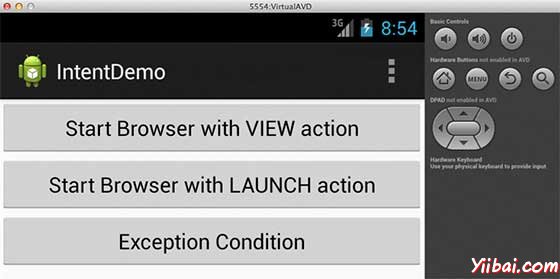
现在,开始第一个按钮“Start Browser with VIEW Action”。这里定义了自定义活动过滤器“android.intent.action.VIEW”,并且已经有一个默认的活动,由Android启动Web浏览器视图定义动作,所以android 显示以下两个选项来选择要启动的活动。
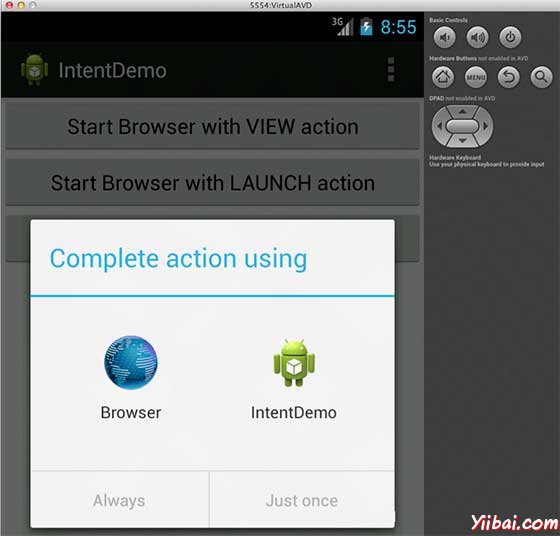
现在,如果选择浏览器,那么Android将启动网页浏览器并打开 example.com 网站,但如果选择“IndentDemo”选项,那么Android将启动CustomActivity什么也不做,只不过是捕捉传递的数据,并显示在文本视图如下:
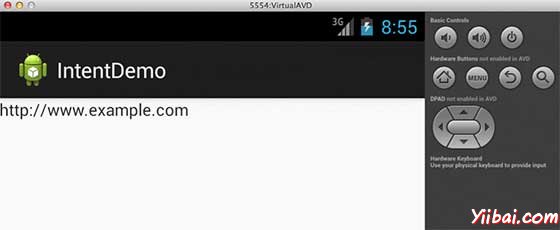
现在使用“后退”按钮,并点击“Start Browser with LAUNCH Action”按钮,这里 Android 应用过滤器来选择定义活动,只需启动自定义活动,再次显示以下画面:
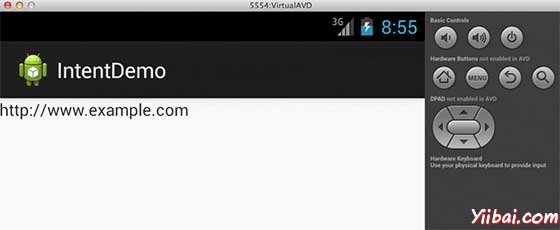
同样,返回使用“后退”按钮,并点击“Exception Condition”按钮,在这里Android试图找出一个有效的过滤器,对于给定intent,它没有找到一个有效活动定义,因为在这个时候,已经数据使用HTTPS,而不是HTTP,虽然是一个正确的动作,但是Android抛出一个异常,并显示以下画面:
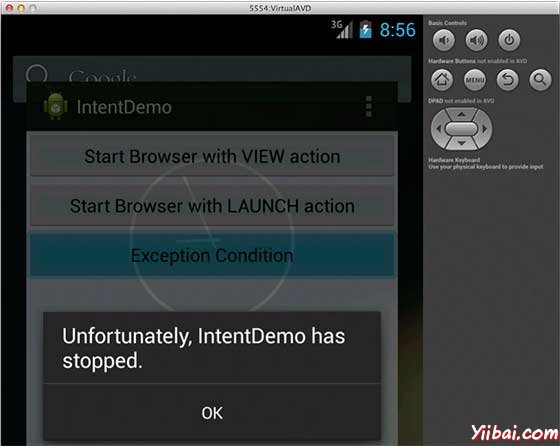
|
